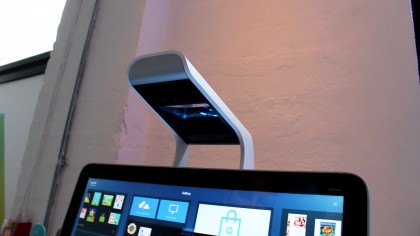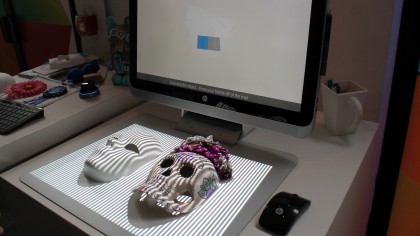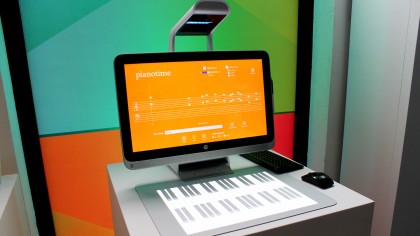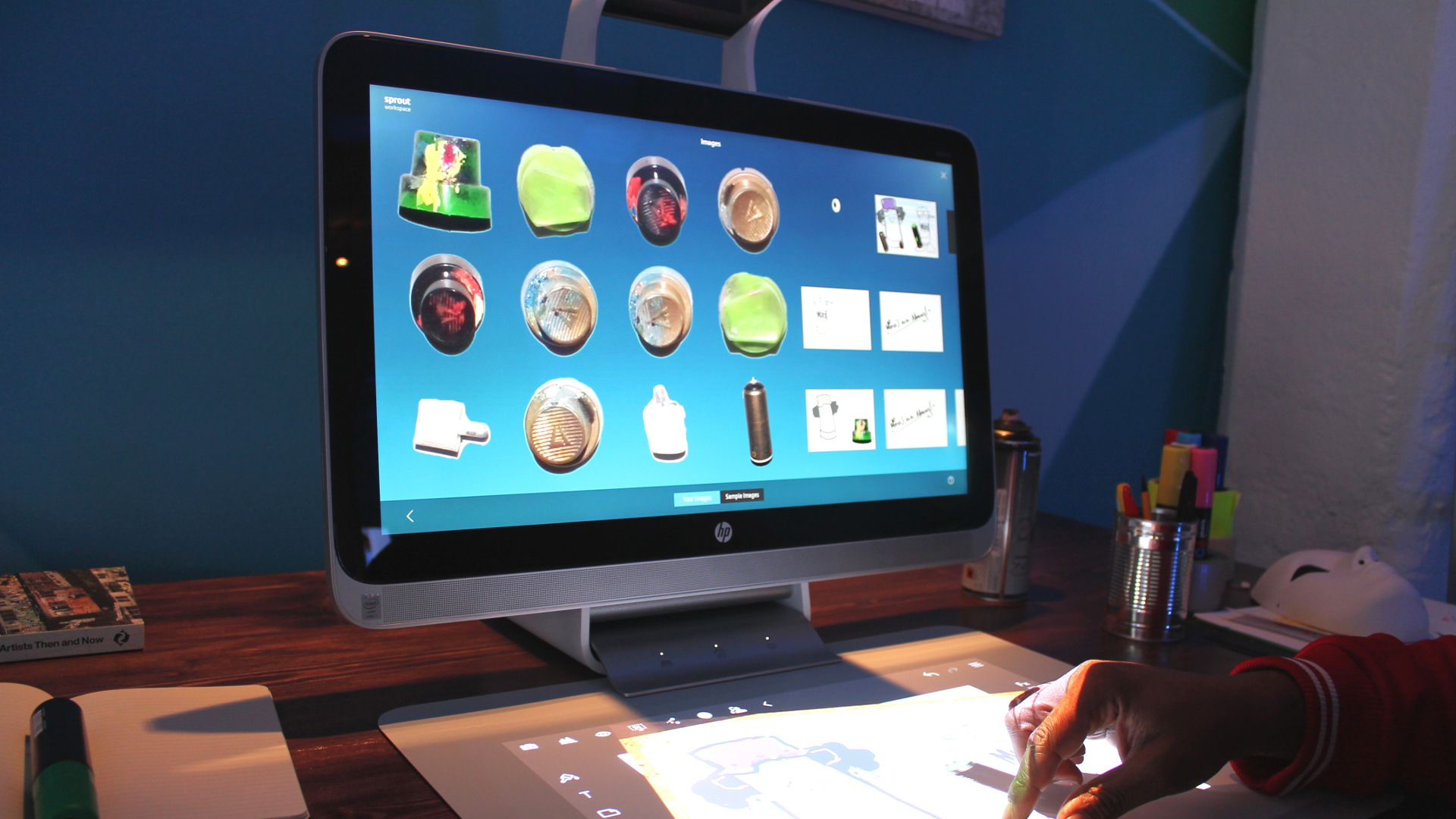Early Verdict
While undoubtedly a work in progress, Sprout is a genuinely exciting desktop computer that promises news ways of working with 3D objects and collaboration-led design.
Pros
- +
Innovative
- +
User-friendly
- +
Decent specs
Cons
- -
Few apps at present
- -
Form factor doensn't benefit certain apps
Why you can trust TechRadar
The HP Sprout is an innovative, quirky and exciting all-in-one PC aimed at content creators, designers and anyone looking for an excuse to ditch their mouse and keyboard.
Available now in the US and UK for $1,899 (£1,899), Sprout's price tag alone hints that it may offer something more than your average Windows 8.1 PC. It certainly succeeds in that, but whether Sprout is for you depends on how prepared you are to approach it with an open mind.
Perched on top of its 23.5-inch display is the Sprout "Illuminator" - a collective term for a 14.6-megapixel camera and integrated Intel RealSense 3D sensor that allows it to capture 2D and 3D objects.

Images scanned by the camera or stored locally can be projected onto a 20-point capacitive touch mat and interacted with using all 10 fingers (and toes, if you're the flexible type).
While 3D scanners and interactive projectors have existed for some time, Sprout's approach integrates the two into a familiar desktop environment in a way that's intuitive, accessible and almost childlike in execution thanks to its hands-on approach.
Capture tool
HP has developed a series of apps that show off what Sprout is capable of. HP Technologist and Sprout inventor Brad Short guided me through them, starting by placing two masks on the mat and tapping a button on its top-left corner to begin the capture process.

Sprout then projected vertical and horizontal black and white stripes over the work surface, which calculates the 3D geometry by measuring the disturbance of patterns, according to Short. It then takes a final 2D image and wraps it over the 3D construction to match up color and depth.
Sign up to the TechRadar Pro newsletter to get all the top news, opinion, features and guidance your business needs to succeed!
Once complete, 3D renders of the masks appeared on the display and the mat turned into a second interactive monitor, allowing them to be rotated, resized and different textures to be applied.
Inside Sprout is an Intel Core i7-4790S CPU backed up by 8GB and an Nvidia GeForce GT745A with 2GB of DDR3 dedicated memory, in addition to a 1TB Hybrid Drive with an 8GB SSD cache.
That's plenty of power for applying large imported textures to objects which is coming in a future update - and HP has confirmed that native 3D printing support will be ready in 2016. Until then, anything designed on Sprout can be exported in .obj format and edited or printed using Autodesk and other apps.

Though in time it will no doubt become as common as printing a 2D sheet of paper is today, seeing the masks spin and shimmer on Sprout's full-HD display within moments of being bathed in a Twilight Zone-style light was impressive - in a novel sort of way.
Blended reality
Short then created a blank surface area and placed the masks beside 2D shapes pulled from a software gallery. HP refers to the capturing and tactile manipulation of digitised objects as "blended reality", and it promises to make it far easier for content creators to import props into their designs while making the content itself more engaging.
Multiple Sprout owners can collaborate over the internet using HP's My Room video calling software, which uses the PC's front-facing HD camera to transmit what's taking place on each user's mat in real-time, with the only restriction being the speed of the network it's operating on.

That's edutainment
Sprout also has potential in the classroom and could help deliver a particular form of teaching called "edutainment" - making learning fun - in other words. Short demonstrated an app that displayed a beating heart on a piece of paper with labels indicating its different parts.
The theory is that interaction with moving images makes learning more engaging, though the presence of paper still allows students to write down answers and absorb information without the strain of looking at a display for extended periods.

Another app called Piano Time displayed notes on the screen and recorded the output after I had tapped on the keys. While it could be used to get children interested in music, the lack of tactile feedback means that, like on a tablet, playing anything that requires skill and precise movements is out of the question. Hammering out Muse's 'Piano Thing' on a projected Sprout keyboard just isn't going to work.
The lack of a tactile controller was less of a problem on a DJ app that projected a pair of turntables onto the mat used for scratching and changing the tempo of the music, but it felt more like a glorified dual-screen tablet than an entirely new experience.

An origami app that projected fold lines onto paper fared better, demonstrating the advantages of having both a projector and a large screen for following instructions. Short is confident that this method of interaction could result in some of Sprout's more inventive applications, with cooking being one of them.
The work surface is large enough to place ingredients on top (a protective cloth would probably be a good idea), and beamed lines could indicate where to chop. HP has released a Sprout SDK for developers looking to develop applications and get to grips with the platform.
Early verdict
Sprout is currently all about demonstrating what can be done with the dual-screen form factor and projection capabilities, and the best is undoubtedly yet to come as its app ecosystem grows and developers get to grips with it.
For creative users, the ability to capture, digitise and manipulate 3D objects could speed up certain processes and potentially change the way designers work forever, while "blended reality" could prove hugely beneficial for certain instruction-led activities and classroom-based learning.
On the other hand, other elements of Sprout, namely certain apps that treat the touch-operated mat as a second screen, are less effective and merely magnify the problems you might experience using a tablet. The overall experience is more a positive than negative one, though whether it warrants shelling out a couple of grand for the pleasure is something we will have to decide on in our full review.
What is a hands on review?
Hands on reviews' are a journalist's first impressions of a piece of kit based on spending some time with it. It may be just a few moments, or a few hours. The important thing is we have been able to play with it ourselves and can give you some sense of what it's like to use, even if it's only an embryonic view. For more information, see TechRadar's Reviews Guarantee.

